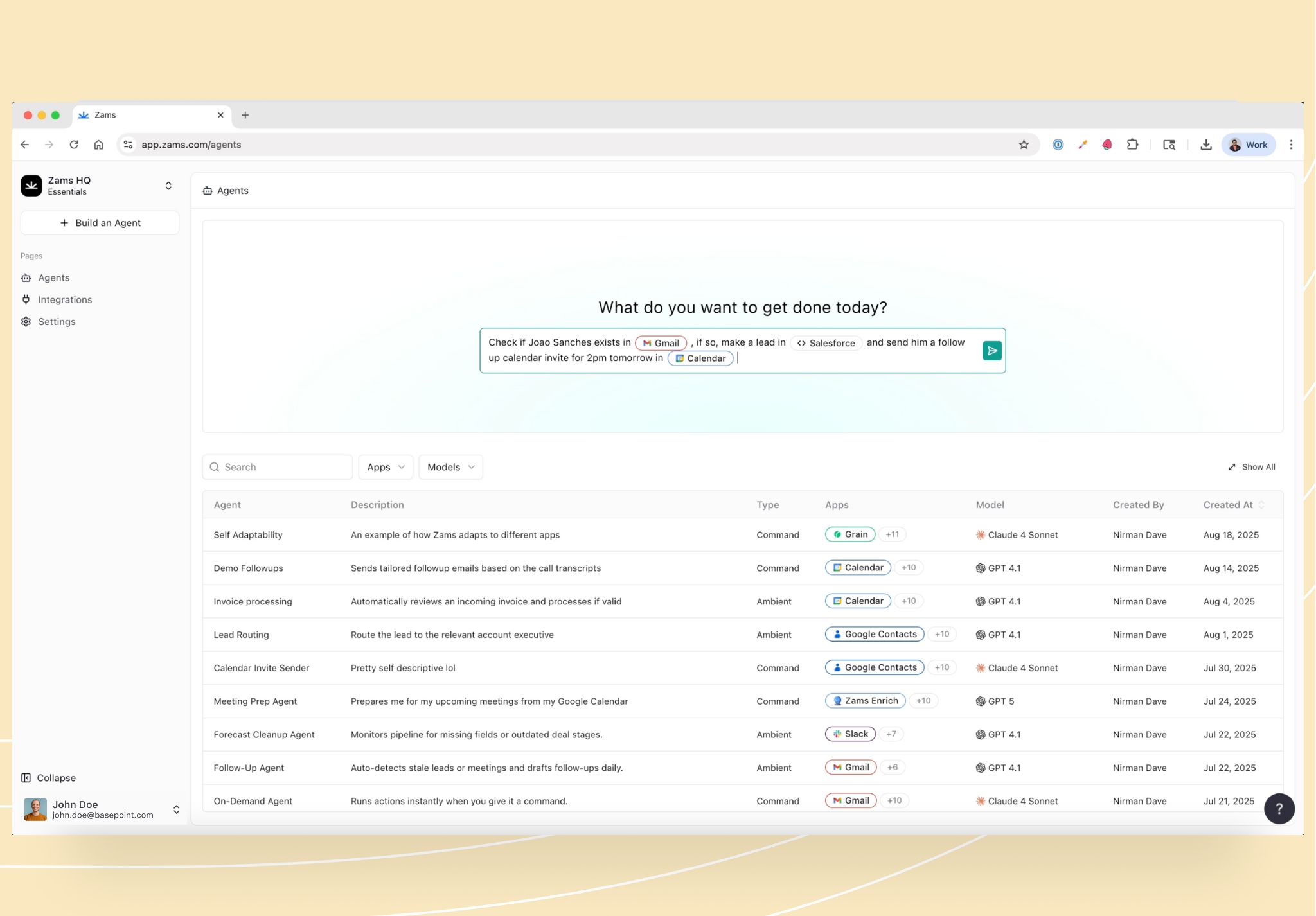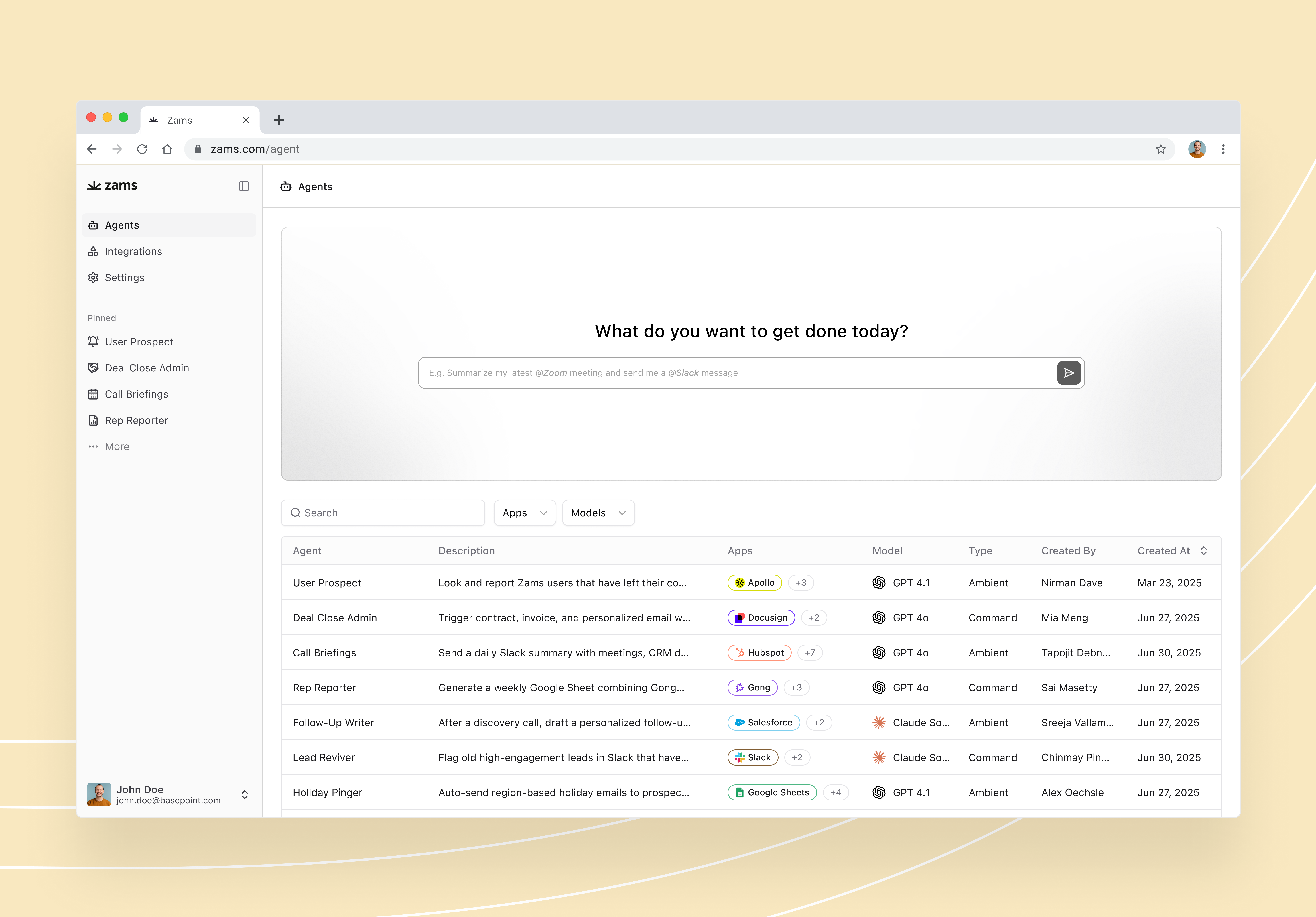Introduction to Sales Automation Software
What is sales automation and why does it matter now?
Sales automation refers to the use of specialized software and tools to automate manual sales tasks such as data entry, lead generation, and follow-up communications. By automating these time-consuming activities, your sales teams can prioritize high-impact opportunities and reduce the administrative workload that often slows down sales performance. In today’s fast-paced and competitive business environment, sales automation is more important than ever. It enables companies to respond rapidly to new leads, adapt to shifting market demands, and consistently drive sales growth. Sales automation gives revenue leaders real leverage - eliminating up to 80% of routine tasks so teams can focus on what actually drives revenue.
The evolution of sales automation software
Sales technology has evolved rapidly over the past decade, with innovations in artificial intelligence (AI), machine learning, and cloud-based platforms revolutionizing the sales landscape. Modern sales automation tools now offer powerful capabilities, from analyzing customer data to predicting sales outcomes and providing personalized recommendations for sales leaders. These advancements have made it possible for teams to work smarter and more efficiently, leveraging automation tools to streamline complex sales processes and deliver better results. As technology continues to advance, sales automation will only become more sophisticated, offering new ways for sales teams to harness data, improve productivity, and stay ahead of the competition.
Accelerate revenue growth with Zams.
Streamline lead capture, automate outreach, and gain real-time sales insights - all in one connected sales automation platform.

The Real Cost of Manual Sales Processes
Why inefficiency drains revenue potential
Manual sales processes slow down the pipeline, cause missed opportunities, and make scaling nearly impossible. Without the efficiency of sales automation software, teams waste valuable selling time on low-impact admin tasks. Automating sales processes ensures every rep can focus on high-value activities that directly drive revenue growth.
Hidden time costs that slow deal velocity
Every extra minute spent manually updating CRM entries, compiling reports, or chasing incomplete lead data delays the sales cycle. These hidden time costs reduce deal velocity and limit overall capacity for new opportunities. By implementing automation sales software, companies eliminate these bottlenecks and keep momentum high from first contact to close.
Where Sales Automation Software Delivers the Biggest Wins
Streamlining lead management, capture and qualification
Sales automation tools capture leads from every channel, using automation to qualify leads and identify qualified leads efficiently. They enrich data instantly and score them based on defined criteria, streamlining the process of managing sales leads and integrating contact management for organized customer information. This ensures your sales reps spend their time on prospects with the highest conversion potential. An automated sales software platform also routes leads to the right rep in real time, maximising follow-up speed. Pipeline management is enhanced by automation, ensuring leads move efficiently through each stage of the sales process.
Automating repetitive outreach with precision
From sales email automation tools to trigger-based workflows, automation eliminates manual outreach tasks while also helping to automate repetitive tasks and automate routine tasks, all while maintaining a personalised touch.
Easy automated sales workflows ensure timely follow-ups, nurture sequences, and customised proposals are sent without delay. This precision outreach uses workflow automations to automate tasks, boosting engagement rates and shortening the sales cycle.
Real-time reporting for smarter decision-making
Sales automation platforms provide real-time dashboards that track pipeline health, campaign performance, and team productivity. Automated reporting replaces manual spreadsheet work, as these platforms can generate custom reports automatically based on selected metrics, ensuring sales leaders have the latest data for accurate forecasting. With marketing and sales automation tools integrated, decision-making becomes faster and more data-driven, unlocking new growth opportunities.

Customer Interactions and Engagement
Customer interactions and engagement are at the heart of every successful sales process. Sales automation plays a pivotal role in enhancing these touchpoints, ensuring that every customer experience is timely, relevant, and impactful. By integrating sales automation into their workflows, sales teams can deliver more personalized communications, respond faster to customer needs, and build stronger, longer-lasting relationships.
Enhancing the buyer journey with automation
Sales automation tools are essential for creating a seamless and engaging buyer journey. By leveraging marketing automation software, businesses can design targeted campaigns that nurture leads and guide them through each stage of the sales funnel. Automation tools analyze customer data to deliver personalized recommendations and trigger timely follow-ups, ensuring that prospects receive the right message at the right moment. This level of personalization not only strengthens customer relationships but also increases the likelihood of converting leads into loyal customers. With sales automation and marketing automation working together, companies can drive sales growth by providing a buyer experience that is both efficient and deeply engaging.
Quantifying ROI Beyond the Obvious
Increased rep productivity and activity levels
Sales automation software frees revenue leaders from repetitive admin work, empowering teams to focus on high-value activities that drive results. With workflows automating lead routing, follow-ups, and data entry, reps can increase outbound touches and have more meaningful conversations - cutting manual work by up to 80%. The result: higher productivity, stronger pipeline coverage, and more deals closed, faster.
Reduced lead response times and higher conversion rates
Automation ensures hot leads are contacted immediately, often within minutes of showing buying intent. This speed to lead significantly improves conversion rates by engaging prospects when interest is at its peak. Sales automation tools also prioritise high-intent leads automatically, ensuring no valuable opportunity slips through the cracks, while helping sales teams close deals faster and increase the number of closed deals.
Better pipeline sales forecasting accuracy
With real-time data collection and automated updates, sales automation platforms eliminate the guesswork in forecasting by providing sales forecasting tools that help predict future sales performance. Pipeline metrics are updated instantly across the sales automation platform, ensuring sales leaders can make accurate predictions based on current activity. This accuracy leads to better resource allocation, sales strategy adjustments, and revenue predictability through improved insights into future sales.
Essential Features That Maximise ROI
Best sales automation tools for B2B growth
The best sales automation tools integrate seamlessly with CRMs, and sales force automation software and sales force automation streamline sales processes by automating routine sales tasks and improving workflow efficiency. These automation sales software solutions enable end-to-end sales process management, from lead capture to deal closure, without manual intervention. When selecting tools, consider a sales automation system that fits your organization's needs.
Sales content automation to keep messaging consistent
Sales content automation ensures every rep sends the right message, at the right time, to the right audience. Pre-approved templates, dynamic personalisation, and brand guidelines built into the sales automation software maintain consistency while reducing preparation time.
Marketing and sales automation features that work in sync
When marketing and sales automation tools are aligned, lead handoffs become seamless, and marketing campaigns and email marketing tools are automated for better targeting and engagement, ensuring nurturing campaigns stay relevant at every stage. This integrated approach ensures marketing-generated leads are properly qualified and sales efforts are supported with targeted, data-driven content. Together, they create a closed-loop system that maximises ROI across both teams.

Integrating Sales Automation Software Into Your Stack
Choosing the right sales automation platform
Selecting the right sales automation software starts with identifying your sales process bottlenecks and core objectives. The best sales automation tools are scalable, user-friendly, and integrate with your existing tech stack. Look for platforms that support lead management, outreach automation, and real-time analytics to drive measurable ROI.
Connecting with CRM Software, marketing, and sales email automation tools
A sales automation platform should work seamlessly with your CRM, marketing automation systems, and sales email automation tools. This ensures that lead data, outreach campaigns, and pipeline updates flow without manual intervention. Proper integration eliminates silos and provides a single source of truth for your sales and marketing teams.
Aligning automation with your sales operations
Automation should be designed to complement your sales process, not replace it. Mapping your automation workflows to each stage of the sales funnel ensures that every task supports your overall strategy. This alignment allows for better lead nurturing, higher conversion rates, and improved customer experience.
Avoiding Common Pitfalls When Automating Sales
Over-automation that risks personalisation
While automation boosts efficiency, too much of it can make interactions feel robotic. Sales automation solutions should include personalisation features to maintain a human touch in every conversation. Balance efficiency with authenticity to keep prospects engaged.
Poor integration planning with existing systems
Without a clear integration plan, even the best sales automation software can create workflow disruptions. Ensure compatibility with current CRM, marketing, and communication tools before implementation. Proper integration ensures smooth adoption and maximises the platform’s potential.
Lack of sales team adoption and training
Automation tools deliver results only if your team uses them effectively. Provide hands-on training, role-specific guidance, and continuous support to encourage adoption. When your reps understand the benefits and workflows, they’re more likely to embrace automation as a core part of their daily sales process.
Final Thoughts
Equipping your revenue engine with Zams alongside your sales automation software ensures every lead is captured, qualified, and nurtured with precision. By combining automation with actionable insights, AI sales assistants and platforms like monday Sales CRM deliver intelligent suggestions, advanced automation, and seamless integrations that empower teams to work smarter. The result: up to 80% less manual work, a faster-moving sales org, more closed deals, and consistent growth.
Equip Your Revenue Engine with Zams and your Sales Automation Software
Power up Sales Automation Software with these Zams integrations:
FAQ
What is sales automation software and how does it work?
Sales automation software streamlines repetitive sales tasks like lead capture, qualification, follow-ups, and reporting. It integrates with CRM and marketing tools to create a connected workflow that helps sales teams focus on high-value activities.
How does sales automation software improve ROI?
By reducing manual tasks, speeding up lead response times, and improving pipeline visibility, sales automation software boosts productivity, shortens sales cycles, and increases conversion rates all contributing to higher revenue.
What features should I look for in the best sales automation tools?
Key features include AI-powered lead scoring, automated email sequences, real-time analytics, sales content automation, and seamless CRM integration for complete data visibility.
How can I integrate sales automation software into my existing tech stack?
Choose a platform that connects easily with your CRM, marketing automation tools, and sales email automation solutions. Plan integrations strategically to maintain clean data and consistent workflows.
What are common mistakes to avoid when implementing sales automation?
Avoid over-automation that removes personalisation, skipping proper integration planning, and failing to train your sales team. Adoption and alignment are critical for success.



